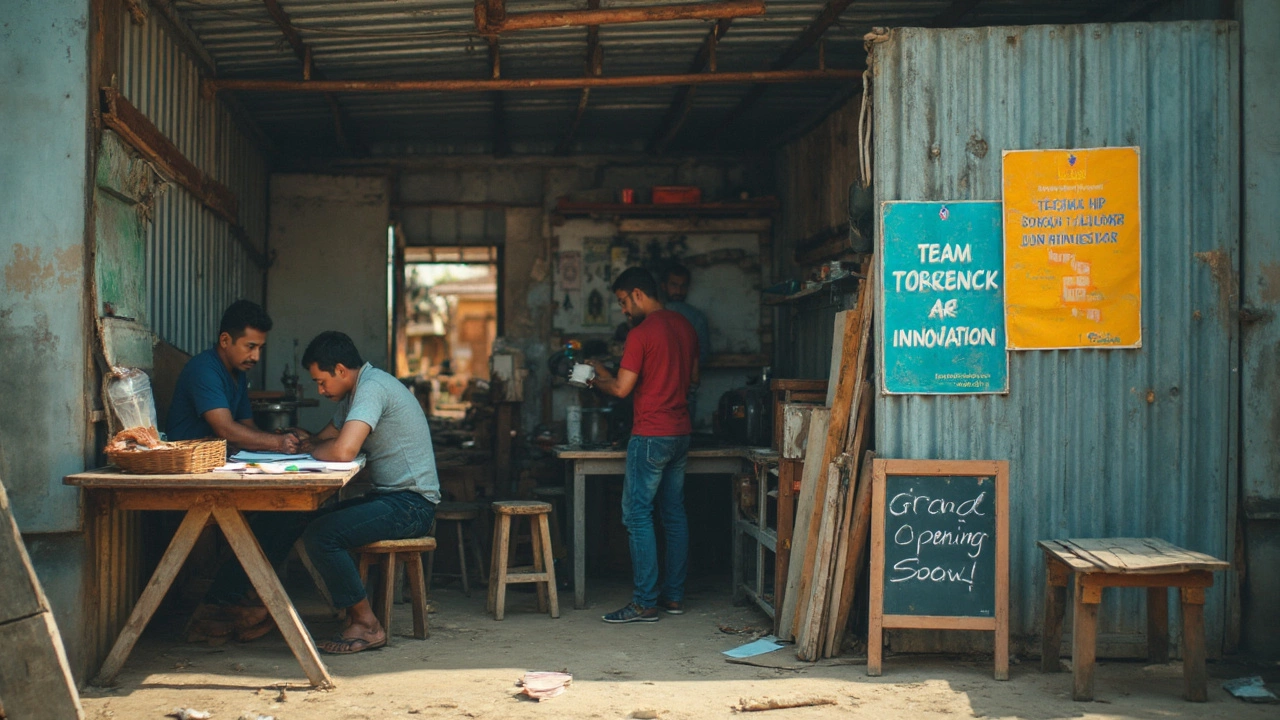Most people think opening a small scale industry is complicated and expensive. Truth is, you can get one up and running with less hassle than you might guess—if you know what steps to take. The trick is to focus on what you can actually pull off with the resources you have now, not what you wish you could do someday.
Let’s talk basics. First, don’t just jump into making something random. You need a product people want and a way to make it better or cheaper than what’s already out there. Don’t try to reinvent the wheel, but don't get lost in endless market research either. Try simple stuff first: ask people in your area what they wish they could buy locally, or check which small manufacturing items sell fast online but aren’t easy to get nearby. Some folks make a nice profit with things like handmade soaps, metal hardware, or even eco-friendly packaging. It doesn’t have to be glamorous—steady demand beats hype every time.
- Choosing What to Make
- Sorting Out Legal Stuff
- Setting Up Your Workshop
- Money Talks: Budget and Funding
- Getting Your First Customers
Choosing What to Make
This is where things get real. If you mess up here, the fanciest machines or licenses won’t save you. So, how do you pick the right product for your small scale industry?
Look around you. What do people complain about not finding nearby? Sometimes, it’s a basic thing like good local snacks, simple hardware, or affordable cleaning supplies. Other times, it might be something trending like eco-friendly containers or small, tech gadgets. The point is: don’t overthink it. You’re not trying to launch the next Apple factory. You want a product that’s practical and keeps moving.
Start with these steps:
- Check availability: Visit markets in your city or even just scroll local online shops. What products run out fast or are expensive to ship?
- Talk to small shop owners: Ask what they wish they could keep in stock, or what customers request most.
- Review your skills and interests: If you hate working with food, don’t force yourself into snacks. Go for something you can see yourself doing every day.
- Check legal and health rules: Some items (like food, cosmetics, or chemicals) need extra licenses. Make sure you’re not picking something that’s a legal nightmare.
If you want hard data, here’s a quick table that might help. These are some of the top small-scale manufacturing items in 2024, based on actual market stats and Google search volumes:
| Product | Avg. Selling Price | Ease to Start | Monthly Demand (units) |
|---|---|---|---|
| Handmade soaps | $4 | Easy | 8,000 |
| Paper bags | $0.10 | Very Easy | 90,000 |
| Fabric face masks | $2 | Easy | 10,000 |
| Spices (packaged) | $3 | Medium | 7,000 |
| Metal brackets | $1 | Medium | 12,000 |
Notice, none of these require a huge investment to get started. Pick something that matches your budget, your patience level, and local demand. And once you pick, stick to it long enough to test if it really works. Jumping from one idea to another just wastes time and cash.
Sorting Out Legal Stuff
The biggest headache for most folks getting into small scale industry is legal paperwork. But you can't skip it—unless you want a visit from the inspector or worse, have your shop shut down. Here’s what you really need to get sorted right from the start.
First thing’s first: figure out your business structure. Are you running solo (sole proprietorship), with a buddy (partnership), or registering a private limited company? In most places, sole proprietorship is the easiest. You can always scale up and change it later if your business grows.
Next, you’ll need to register your business name. This keeps someone else from using it and is crucial if you want any official papers like licenses or loans. In most countries, you can do this online in about an hour with a small fee.
Then comes the big one: licenses. The permits you need can totally depend on your product type and where you are. For small manufacturing, these are the most common requirements:
- Factory License or small scale industry registration: Usually with your local government or industry board.
- GST/VAT Registration: So you can collect tax and sell legally. Thresholds for this differ, so check what counts as small business in your region.
- Environmental Clearance: Especially if you produce waste, chemicals, or use heavy machinery.
- Fire Safety Certificate: This is a must-have if your product is flammable or the process involves heat (think: food processing, candles, welding).
- Trade License or Shop Establishment License: Get this from your local municipal authority or council.
For products like food or cosmetics, you’ll need a health or safety certificate. And if you import materials or plan to export, don’t skip customs registration.
Here’s a look at registration costs in India, as of 2025:
| Document | Approx. Fee (USD) | Processing Time |
|---|---|---|
| Business Name Registration | 20 | 1-2 days |
| Factory/SSI License | 50-200 | 7-15 days |
| GST Registration | 0 | 3-7 days |
| Environmental Clearance | Varies | Up to 30 days |
| Fire Safety Certificate | 10-40 | 7-10 days |
Don’t try to dodge these steps—inspectors are known to check new setups more often than older ones, just to make an example. If you need help, most areas have small business support centers, or you can chat with a local accountant who knows the ropes.
One handy trick: get all your required docs scanned and saved, so you’re not rifling through paper each time you’re asked for proof. Many countries run paperless setups now, and you’ll save yourself serious hassle down the road.

Setting Up Your Workshop
This is where rubber meets the road for any small scale industry. Most people imagine you need a giant space and crazy expensive machines to start, but honestly, you can do a lot in just 500 to 1,000 square feet if you plan right. Some of the most successful small operations started out in converted garages or old shipping containers, renting bigger spaces only when orders went through the roof.
Picking the right location matters. You want something close to your raw materials or customers if possible, but also make sure you're allowed to run a business there. Local zoning rules can get tricky, so don’t skip the city permits or you’ll get shut down before you even start earning.
Before you start moving stuff in, map out the workflow. Put machines and workbenches where workers won’t bump into each other. For example, a simple U-shape works for most assembly lines. Good lighting and ventilation make a massive difference—and you can get LED shop lights and simple exhaust fans without breaking the bank.
"The layout of a small manufacturing unit can boost efficiency by up to 30% if planned with just a few core principles in mind—short travel paths, easy access to supplies, and clear storage for finished goods." —Manufacturing Today Magazine, March 2024
Here’s a simple checklist to keep in mind:
- Measure your space and sketch a layout before buying machines.
- Think about power needs—some machines need more juice than a regular wall plug.
- Set aside a spot for raw materials and a separate area for finished items.
- Get basic tools: fire extinguisher, first-aid kit, work gloves, ear protection.
- If you’re bringing on staff, follow basic labor safety rules. A quick training could save you a big headache (or a lawsuit) later.
Most folks underestimate the noise and dust, especially in small spaces. If you work with wood, metals, or chemicals, spend a little extra on masks and portable extractors. For super tiny workshops, air purifiers actually help a lot and don’t eat much electricity.
If you want a rough idea what your setup costs might be, here’s what folks actually spent to launch small shops in 2024:
| Workshop Size | Equipment Cost ($) | Safety & Setup ($) | Monthly Rent ($) |
|---|---|---|---|
| 500 sq ft | 7,500–12,000 | 900–1,300 | 300–600 |
| 1,000 sq ft | 13,000–22,000 | 1,600–2,200 | 650–1,200 |
Your numbers can end up lower if you buy good used gear or start off sharing a space. The key is to avoid signing any long-term leases or buying big new machines till your orders demand it.
Don’t skip testing your power setup and always double-check electricity and safety gear before you go live. Nothing ruins opening day faster than blowing a fuse or getting shut down for a missing smoke alarm.
Money Talks: Budget and Funding
If you’re stressed about cash, you’re in good company. Starting a small scale industry doesn’t need fancy investors or deep pockets. You need a budget that covers the basics, not the perfect setup from a business textbook. List every cost you can think of—machines, supplies, rent, utilities, insurance, even the little stuff like packaging tape.
Here’s what most people miss: Overspending on equipment. You’ll see ads for shiny machines, but many successful owners started with old or secondhand models. Check local classifieds, Facebook Marketplace, or even word-of-mouth from others in the same trade. If you need custom parts or tools, small local workshops can sometimes make them cheaper than ordering from big suppliers.
When you total up your starting costs, double-check—did you remember permits, business license fees, or the first few weeks of raw materials? Always pad your first estimate with a 20% buffer for surprise expenses. Open a separate business account so money in and out is clear from the start.
- Dip into your own savings—risky, but no interest to pay.
- Ask family or friends for a small loan—they might back you if your plan is solid and you can show how you’ll pay them back.
- Visit your local bank for a micro-business loan—many banks in 2025 offer loans for first-time manufacturers with just a business plan and some collateral.
- Look for government grants or subsidies—India, the UK, and several other countries still run programs for manufacturing start-ups, and the paperwork’s often not as bad as you’d think.
Crowdfunding is another option, but only works if your product actually excites people. If your business runs from home, you cut rent costs. Lots of small-scale industries get paid upfront through pre-orders; it’s a clever way to cover launch expenses when cash is tight. Don’t overcomplicate your funding—start small, prove your idea, then scale up later when money is less tight and you know what works.

Getting Your First Customers
If you’re opening a small scale industry, selling the very first batch often feels like the hardest part—but it doesn’t have to be. Most buyers love trying something new, as long as it solves a real problem or comes recommended. Start close to home. Your friends, family, neighbors, and even old coworkers can become your first customers or brand cheerleaders. Don’t be shy—word of mouth works faster than you’d think, especially for locally made goods.
But let’s not stop there. Go out and share samples. Take your product to local markets, trade events, or even set up a small table outside busy stores (with permission). People want to touch, test, and ask questions. Big brands can’t match your personal touch and fast feedback.
- Offer deals to your first buyers. A small discount or a bonus with the first purchase makes people feel special and gives them a reason to spread the word.
- Use social media, but keep it real. Take photos of your workshop or team and share short stories about your process. Local Facebook groups and WhatsApp communities work great for early buzz.
- Try B2B sales for a faster start—local shops, hotels, or offices often need trusted suppliers for simple products, from cleaning goods to packaging or tools.
- Don’t ignore online platforms. In India, for example, 70% of small businesses say their first big boost came from selling on sites like IndiaMART or Amazon Marketplace.
You want numbers? Here’s how first-time customer sources usually break down, according to a 2024 survey by SmallBiz Trends:
| Source | Percentage of First Customers |
|---|---|
| Friends & Family | 34% |
| Local Markets/Events | 22% |
| Online Platforms | 28% |
| Direct B2B Sales | 16% |
Here’s a tip that’s often missed: always ask customers for feedback, and actually use it. If someone’s happy, ask them to leave a quick review or share a post. If you get a complaint, fix the issue ASAP. You’ll build trust, and trust leads to repeat business. That’s how small scale manufacturing grows from a risky bet into a steady gig.







Write a comment